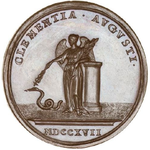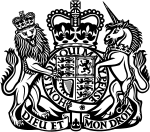Indemnity Act 1717
| Act of Parliament | |
 | |
| Long title | An act for the King's most gracious, general and free pardon. |
|---|---|
| Citation | 3 Geo. 1. c. 19 |
| Dates | |
| Royal assent | 15 July 1717 |
| Repealed | 15 July 1867 |
| Other legislation | |
| Repealed by | Statute Law Revision Act 1867 |
Status: Repealed | |

| English, Scottish, Irish and Great Britain legislation |
| Acts of parliaments of states preceding the United Kingdom |
|---|
 |
The Indemnity Act 1717 (3 Geo. 1. c. 19, also referred to as the Act of Grace and Free Pardon, is an act of the Parliament of Great Britain.
The act was passed by both houses of parliament in July 1717, the last enactment of the session.[1] It followed almost two years after the Jacobite rising of 1715, during and after which many Jacobites were taken prisoner. Those later convicted of treason were condemned to death, and some were executed, but by the Act most of the surviving Jacobite prisoners were freed and were permitted to settle either at home or overseas.[2]
Hundreds of Jacobites were freed by the act.[1] The more notable included the Earl of Carnwath, Lord Nairne, and Lord Widdrington, together with seventeen gentlemen awaiting execution in the Newgate and twenty-six in Carlisle Castle. Some two hundred men captured at the Battle of Preston were released at Chester, also all remaining prisoners held in the castles of Edinburgh and Stirling. The Act did not undo the effect of any attainders, and confiscated estates worth £48,000 a year in England and £30,000 a year in Scotland; the dispossessed owners were not restored of their property.[1]
There were some specific exceptions to the general pardon granted by the act: Matthew Prior and Robert Harley, 1st Earl of Oxford, had been held in the Tower of London before the Rising of 1715, and Oxford's friend Lord Harcourt and his cousin Thomas Harley. All members of the Clan MacGregor were also excluded from the Act's benefits,[1] one of the targets of this last exclusion being the famous Rob Roy MacGregor.[2] Philip Henry Stanhope noted in the 1840s that "a modern reader is shocked to find excepted 'all and every person of the name and clan of Macgregor'".[1]
The passage of the act was marked by the issuing of a silver medal, also struck in bronze, engraved by John Croker, chief engraver to the Royal Mint.[3][4] On the obverse is the head of King George I, on the reverse is the winged figure of Clemency, who is standing, but leaning by her left elbow on a short stone pillar, surrounded by the words "CLEMENTIA AVGVSTI". In her left hand is an olive branch, while in her outstretched right hand she holds a caduceus, with which she touches the head of a fleeing snake, representing Rebellion. This image recalls the story of the caduceus of Mercury.[5]
Notes
[edit]- ^ a b c d e Philip Henry Stanhope, Henry Reed, History of England from the Peace of Utrecht to the Peace of Versailles (1849), p. 206
- ^ a b Peter Hume Brown, A History of Scotland to the Present Time, p. 154
- ^ The Numismatic Circular, volumes 30–32 (1922), p. 467
- ^ Medal (reverse), commemorating the Act of Grace of 1717 at web site of National Museums of Scotland, accessed 17 December 2013
- ^ New Gallery, London, Exhibition of the Royal House of Stuart (London: Richard Clay and Sons, 1889), p. 207

